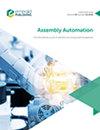Parameter tuning of auto disturbance rejection controller based on improved glowworm swarm optimization algorithm
IF 1.7
4区 计算机科学
Q3 AUTOMATION & CONTROL SYSTEMS
引用次数: 3
Abstract
Purpose This paper aims to study a parameter tuning method for the active disturbance rejection control (ADRC) to improve the anti-interference ability and position tracking of the performance of the servo system, and to ensure the stability and accuracy of practical applications. Design/methodology/approach This study proposes a parameter self-tuning method for ADRC based on an improved glowworm swarm optimization algorithm. The algorithm is improved by using sine and cosine local optimization operators and an adaptive mutation strategy. The improved algorithm is then used for parameter tuning of the ADRC to improve the anti-interference ability of the control system and ensure the accuracy of the controller parameters. Findings The authors designed an optimization model based on MATLAB, selected examples of simulation and experimental research and compared it with the standard glowworm swarm optimization algorithm, particle swarm algorithm and artificial bee colony algorithm. The results show that the response time of using the improved glowworm swarm optimization algorithm to optimize the auto-disturbance rejection control is short; there is no overshoot; the tracking process is relatively stable; the anti-interference ability is strong; and the optimization effect is better. Originality/value The innovation of this study is to improve the glowworm swarm optimization algorithm, propose a sine and cosine, local optimization operator, expand the firefly search space and introduce a new adaptive mutation strategy to adaptively adjust the mutation probability based on the fitness value, improve the global search ability of the algorithm and use the improved algorithm to adjust the parameters of the active disturbance rejection controller.基于改进萤火虫群优化算法的自抗扰控制器参数整定
目的研究一种自抗扰控制(ADRC)的参数整定方法,以提高伺服系统的抗干扰能力和位置跟踪性能,保证实际应用的稳定性和准确性。设计/方法/途径本研究提出了一种基于改进的萤火虫群优化算法的自适应自抗扰控制器参数自整定方法。采用正弦余弦局部优化算子和自适应变异策略对算法进行了改进。将改进算法用于自抗扰控制器的参数整定,提高了控制系统的抗干扰能力,保证了控制器参数的准确性。结果基于MATLAB设计了优化模型,选取仿真和实验研究实例,并与标准的萤火虫群优化算法、粒子群算法和人工蜂群算法进行了比较。结果表明:采用改进的萤火虫群优化算法对自抗扰控制进行优化,响应时间短;没有超调;跟踪过程相对稳定;抗干扰能力强;优化效果较好。本研究的创新之处在于改进了萤火虫群优化算法,提出了一种正弦余弦局部优化算子,扩展了萤火虫的搜索空间,并引入了一种新的自适应突变策略,基于适应度值自适应调整突变概率,提高了算法的全局搜索能力,并利用改进算法对自抗扰控制器的参数进行了调整。
本文章由计算机程序翻译,如有差异,请以英文原文为准。
求助全文
约1分钟内获得全文
求助全文
来源期刊

Assembly Automation
工程技术-工程:制造
CiteScore
4.30
自引率
14.30%
发文量
51
审稿时长
3.3 months
期刊介绍:
Assembly Automation publishes peer reviewed research articles, technology reviews and specially commissioned case studies. Each issue includes high quality content covering all aspects of assembly technology and automation, and reflecting the most interesting and strategically important research and development activities from around the world. Because of this, readers can stay at the very forefront of industry developments.
All research articles undergo rigorous double-blind peer review, and the journal’s policy of not publishing work that has only been tested in simulation means that only the very best and most practical research articles are included. This ensures that the material that is published has real relevance and value for commercial manufacturing and research organizations.
 求助内容:
求助内容: 应助结果提醒方式:
应助结果提醒方式:


